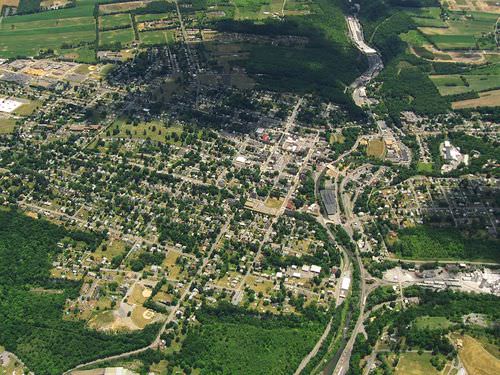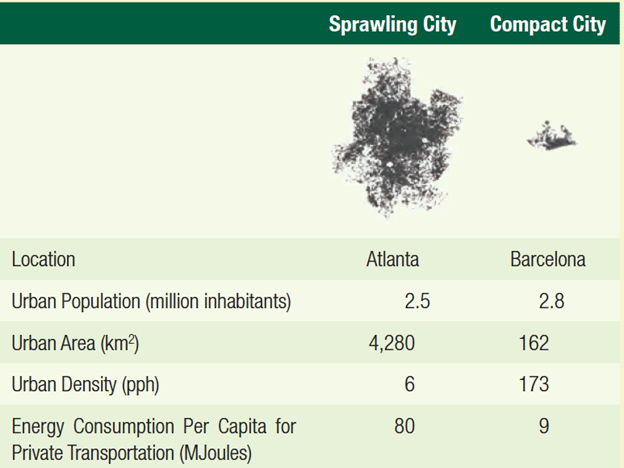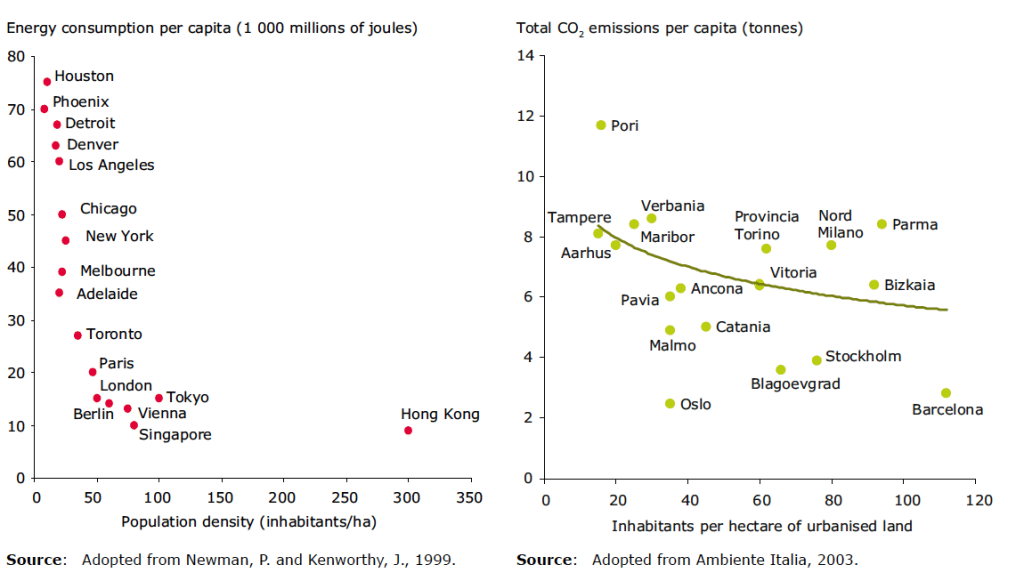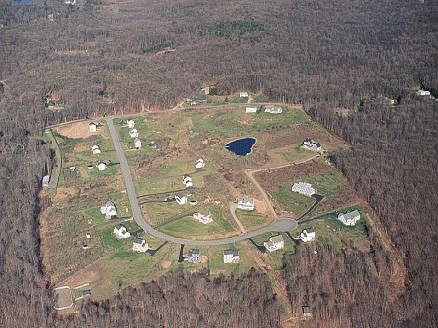Urban sprawl is the extension of low-density residential, commercial, and industrial development into areas beyond a city’s boundaries that occur unplanned or uncoordinatedly (Figure 1). It is generally characterized by the following:
- low-density development that is dispersed and situated on large lots (greater than one acre)
- geographic separation of essential places such as work, home, school, and shopping
- high dependence on automobiles for travel
- increased impervious surface area in watersheds
- habitat fragmentation and degradation

Urban sprawl combines low density and fragmentation of the urban area (Figure 2), increases the average travel distances for daily trips, and hinders a shift toward less energy-intensive transportation modes. The sprawling nature of cities is critically important because of the major impacts of increased energy, land, and soil consumption. These impacts threaten the natural and rural environments, raising greenhouse gas emissions that cause climate change and elevated air and noise pollution levels, often exceeding the agreed human safety limits. Thus, urban sprawl produces many adverse impacts that directly affect the quality of life.

Health
If communities are not walkable or bikeable, we must drive to schools, shops, parks, entertainment, play dates, etc. Thus we become more sedentary. Residents of sprawling counties were likely to walk less during leisure time and weigh more than residents of compact counties. A sedentary lifestyle increases the risk of overall mortality, cardiovascular disease, and some types of cancer. Low physical fitness’s effect is comparable to hypertension, high cholesterol, and diabetes.
Consumption of Energy
The growing energy consumption is a consequence of the increasing consumption of land and reductions in population densities as cities sprawl. Generally, compact urban developments with higher population densities are more energy efficient. Evidence from 17 cities worldwide shows a consistent link between population density and energy consumption (Figure 3), particularly high energy consumption rates associated with lower population densities, characteristic of sprawling environments, dependent on lengthy distribution systems that undermine efficient energy use.

Transport-related energy consumption in cities depends on various factors, including the nature of the rail and road networks, the extent of the development of mass transportation systems, and the modal split between public and private transport. Evidence shows a significant increase in travel-related energy consumption in cities as densities fall. Essentially, the sprawling city is dominated by relatively energy-inefficient car use, as the car is frequently the only practical alternative to more energy-efficient, but typically inadequate, relatively and increasingly expensive public transportation systems. Increased transport-related energy consumption is, in turn leading to an increase in the emission of CO into the atmosphere. Urban sprawl poses significant threats to the commitments to reduce GHG gas emissions.
Air pollution
Using fossil fuels also emits other gases and particulates that degrade air quality (note that commuters generate air pollution emissions, which lowers the ambient quality of the air in areas they pass through and causes health problems for other people). Longer transportation distances intensify traffic congestion, resulting in lost productivity, and increase the need for more extensive infrastructure (such as more highways) that negatively impact the environment by increasing impervious cover and requiring more natural resources. Finally, traffic congestion and air pollution from driving contribute to an estimated 900,000 fatalities annually.
Natural and Protected areas
The impacts of sprawl on natural areas are significant. The considerable impact of urban sprawl on natural and protected areas is exacerbated by the increased proximity and accessibility of urban activities to natural areas, imposing stress on ecosystems and species through noise and air pollution. Immediate impacts such as the loss of agricultural and natural land or the fragmentation of forests (Figure below), wetlands, and other habitats are well-known direct and irreversible impacts. Urban land fragmentation, with the disruption of migration corridors for wildlife species, isolates these populations and can reduce natural habitats so that the minimum area required for the viability of species populations is no longer maintained.
The environmental impacts of sprawl are evident in a number of ecologically sensitive areas located in coastal zones and mountain areas. The Mediterranean coast, one of the world’s 34 biodiversity hotspots, is particularly affected, and the increased demand for water for urban use competes with irrigation water for agricultural land. This problem has been exacerbated by the increased development of golf courses in Spain, where the over-extraction of groundwater has led to saltwater intrusion into the groundwater. Increased transit and tourist traffic, particularly day tourism from the big cities, also adds to exploiting the mountain areas as a natural resource for ‘urban consumption’ by the lowland populations.

Rural Environments
The growth of European cities in recent years has primarily occurred on former agricultural land. Typically, urban development and agriculture compete for the same land, as agricultural lands adjacent to existing urban areas are also ideal for urban expansion. The loss of agricultural land has a major impact on biodiversity, with the loss of valuable biotopes for many animals, particularly birds. Sprawling cities also threaten to consume the best agricultural lands, displacing agricultural activity to less productive areas (requiring higher inputs of water and fertilizers) and more remote upland locations (with increased risk of soil erosion).
Soil
Urban sprawl and urban land development dramatically transform soil properties, reducing its capacity to perform its essential functions. These impacts are evident in the extent of soil compaction, leading to impairment of soil functions; loss of water permeability (soil sealing) which dramatically decreases; loss of soil biodiversity; and reductions of the capacity for the soil to act as a carbon sink. In Germany, for example, it is estimated that 52 % of the soil in built-up areas is sealed (or the equivalent of 15 m2 per second over a decade). In addition, rainwater that falls on sealed areas is heavily polluted by tire abrasion, dust, and high concentrations of heavy metals, which degrade the hydrological system when washed into rivers.
Water Quality
Increasing numbers of roads and parking lots are needed to support an automobile transportation system, which leads to increased non-point source water pollution and contamination of water supplies (road runoff of oil/gas, metals, nutrients, and organic waste, to name a few) with possible impacts on human health. Increased erosion and stream siltation cause environmental damage and may affect water treatment plants and thus affect water quality.
Socio-economic Impacts
From a social perspective, urban sprawl generates greater segregation of residential development according to income. Consequently, it can exacerbate urban social and economic divisions. The socioeconomic character of suburban and peripheral areas is typified by middle and upper-income families with children with the necessary mobility and lifestyle to enable them to function effectively in these localities. However, the suburban experience for other groups, including the young and old, who lack mobility and resources, can be very different and reduce social interaction. Furthermore, large segments of urban society are excluded from living in such areas. From an economic perspective, urban sprawl is, at the very least, a more costly form of urban development due to the following:
- increased household spending on commuting from home to work over longer and longer distances;
- the cost to businesses of the congestion in sprawled urban areas with inefficient transportation systems;
- the additional costs of extending urban infrastructures across the urban region include utilities and related services.
Urban sprawl inhibits the development of public transport and solutions based on the development of mass transportation systems and the provision of alternative choices in transportation that are essential to ensure the efficient working of urban environments. These conclusions are reinforced by experience from both Munich and Stockholm, where the efficient control of urban sprawl and a resulting increase in population densities fosters the use of public transport and reduces the growth of car use.
Social Capital
On the social sustainability side, we can look at social capital, otherwise defined as the “connectedness” of a group built through behaviors such as social networking and civic engagement, along with attitudes such as trust and reciprocity. Greater social capital has been associated with healthier behaviors, better self-rated health, and fewer negative results, such as heart disease. However, social capital has been diminishing over time. Proposed causes include long commute times observed in sprawling metropolitan areas. As of 2011, according to an article in the Chicago Tribune, Chicago commuting times are some of the worst – with Chicagoans spending 70 hours per year more on the road than they would if there was no congestion – up from 18 hours in 1982. They have an average commute time of 34 minutes each way. These drivers also use 52 more gallons per year per commuter.

